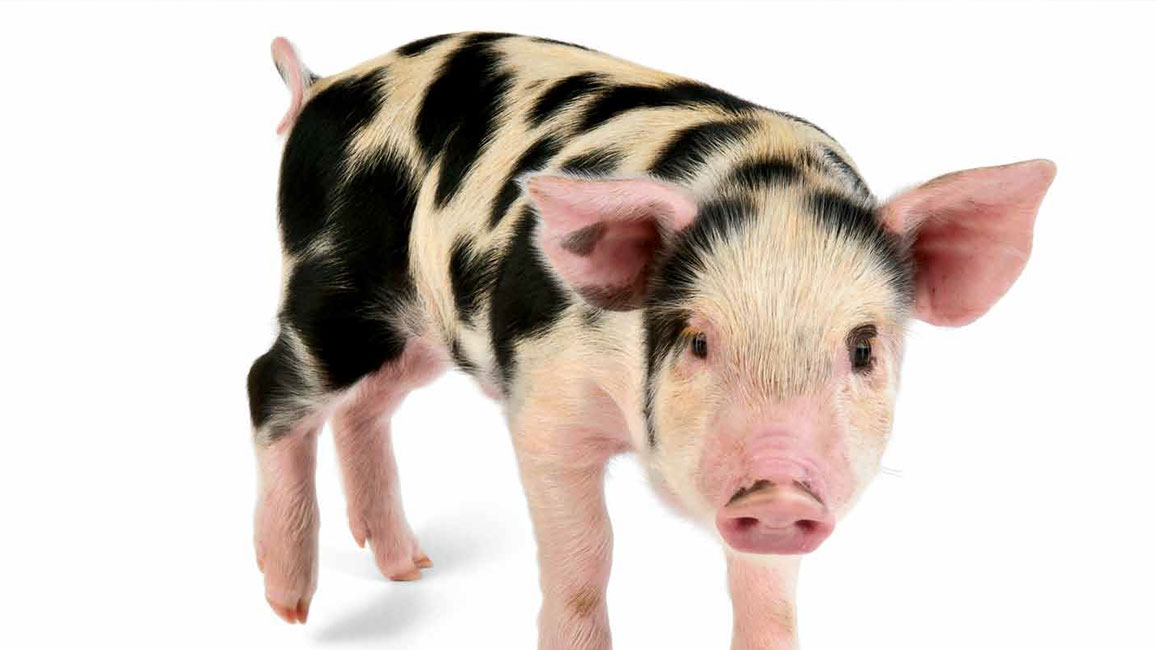
You Think You Know Pigs?
By Hannah SchardtThey’re pink, sweaty, and lazy, right? WRONG! Read this Q&A to get the real dirt on pigs.
1. What makes a pig a pig?
For starters, there’s that snout. It’s big, strong, and flexible, with a great sense of smell. And it’s just right for sniffing out and digging up tasty treats underground.
Pig feet are also pretty special. Look at the hooves on the spotted pig above. It almost looks as if it’s wearing high heels. Pigs have four toes on each foot, but they usually stand only on the tips of the front two toes.
2. Are all pigs pink and hairless?
Many domestic pigs—the ones raised on farms—look pink (or spotted) and almost hairless. But wild pigs come in all shapes, sizes, and colors. The shaggy-maned, brown warthog has four warty bumps on its face. The red river hog has reddish fur and long, white whiskers on its cheeks. It’s hard to believe these two are Babe’s cousins!
3. How smart are pigs?
Pretty smart! In fact, some scientists believe they are even smarter than dogs. Pigs can be trained to do all sorts of tricks: jump through hoops, use mirrors to find food, and herd sheep. They can even use joysticks to play video games. So the next time someone calls you “pig-headed,” you can say, “Thanks.”
4. Are pigs dirty?
Pigs actually like to be clean. They’d rather not sleep in dirty bedding, and they are careful to poop far away from where they eat. But as you can see below, pigs do love mud. And there are good reasons for that. You may have heard the saying, “He sweats like a pig.” Well, pigs don’t sweat at all. So on hot days, they roll in mud to keep cool. Mud also makes a good sunscreen and insect repellent. (Try telling that to your parents next time you come to the back door covered in mud!)
5. Are pigs slow?
Wild pigs are surprisingly speedy. They have to be. In the wild, pigs sometimes have to outrun predators such as lions or leopards. At top speed, a warthog can run 30 miles an hour. That might be faster than the speed limit in your neighborhood!
6. Where do pigs live?
Just about everywhere! Domestic pigs are raised all over the world. Wild pigs live in Africa, Asia, and Europe. They roam throughout woodlands, swamps, grasslands— even cities. (More on that later.) North and South America are home to their own pig-like animals: three species of peccary. Peccaries including the fuzzy collared peccary are not true pigs but are close relatives.
7. What do pigs “pig out” on?
Pigs are built for rooting, or digging in the earth with their snouts for underground food. Meals of mushrooms, worms, and grubs make for a dirty snout. Depending on where they live, pigs will also eat grass, berries, acorns, cactus, and animals such as snails and small snakes.
8. What are pig families like?
Mama pigs such as the wild boar below give birth to several piglets at a time—usually four to six, and sometimes as many as fourteen! Even after the piglets grow up, the females, called sows, often stay with their moms. Adult males, called boars, leave to hang out on their own.
Problem Pigs
Wild pigs belong in the wild, and domestic pigs belong on farms. But sometimes wild pigs move into cities. And sometimes domestic pigs escape and become wild, or feral (FAIR-ul). Both can cause big problems. The wild boar family above lives in Berlin, Germany. When boars in nearby forests figured out that they could find food and shelter in town, they moved right in. Some Berliners enjoy their piggy neighbors. But the boars tear up vegetable gardens, dig in lawns, and cause hundreds of traffic accidents each year. The first domestic pigs were brought to North America hundreds of years ago. Since then, many of them have escaped and become wild. Now millions of feral pigs live in North America. They trample and dig up native plants. Their rooting also tears up the soil. And they are such big eaters that sometimes they don’t leave enough food for other wild animals to survive.



















